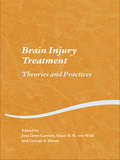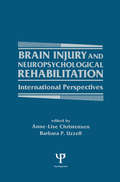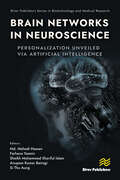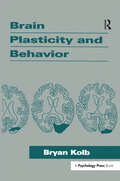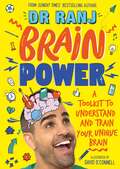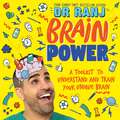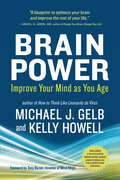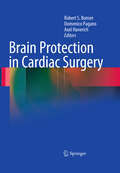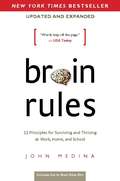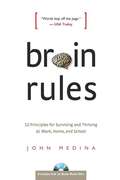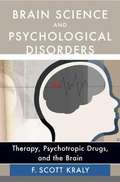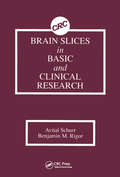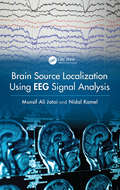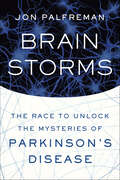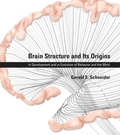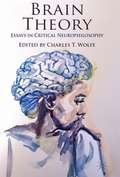- Table View
- List View
Brain Immune System Signal Molecules in Protection from Aerobic and Anaerobic Infections (Advances in Neurobiology #6)
by Armen A. GaloyanProline-rich polypeptides - in particular (PRP-1) galarmin and its structural analogues - are, when isolated from the neurosecretory granules of neurohypophysis of humans and animals, a new type of hypothalamic peptides. They work against aerobic, anaerobic, gram-positive, and gram-negative microorganisms in vivo, and do not have etiotropic properties. They are unique and capable substitutes to antibiotics, and, moreover, may be effective against strains, such as MRSA, that develop resistance to antibiotics. Galarmin, a component of the brain neuroendocrine system produced by the neurosecretory cells of hypothalamus, possesses immunomodulative, neuroprotective, antioxidant, antitumorigenic and hematopoietic properties. Moreover, galarmin and its structural analogues are powerful anti-inflammatory compounds. In addition to presenting a full overview of the neuroimmune system, it emphasizes the antibacterial, neuroprotective, and neuroregenerative properties of proline-rich polypeptides. It investigates the mechanism of galarmin's action during different infectious processes, where it targets such dangerous pathogens as Bacillus anthracis, Clostridium perfringens, Mycobacterium tuberculosis, and Methycillin resistant Staphylococcus aureus. This research is important from both a theoretical and a clinical point of view, creating new prospects for the modern pharmaceutical industry and neuroendocrine, neuroimmunological sciences. Dr. Galoyan is a pioneer of the specialized field of neuroimmunology. During his 45-year long career, he has discovered a neuroendocrine immune system of the brain and identified a new type of brain cytokines: proline-rich polypeptides. The most important of these, PRP-1 (galarmin) has been shown to possess antibacterial properties and protect from certain neurotoxins.
Brain Injury Treatment: Theories and Practices (Studies on Neuropsychology, Neurology and Cognition)
by Jose Leon-Carrion Klaus R. von Wild George A. ZitnayBrain Injury Treatment: Theories and Practices is a thorough and wide-ranging account of the rehabilitation of brain injury. Written from an international perspective, this book presents a detailed discussion of the basic science of brain injury. It explains the treatments used in brain injury rehabilitation and covers new methods of rehabilitation, including complementary medicine theories. It contains a wealth of information on different neurosurgical and neuropsychological treatments. It also includes a comprehensive reference to the theories underlying rehabilitation practices and chapters on community reentry and family dynamics following brain injury. It will be an invaluable tool to students from psychology, medicine, physical and occupational therapy studying the treatment and aftercare of people with brain injury.
Brain Injury and Neuropsychological Rehabilitation: International Perspectives (Institute for Research in Behavioral Neuroscience Series)
by Barbara P. Uzzell Anne-Lise ChristensenMost individuals with brain damage experience a curtailment or loss of lifestyle without rehabilitation. Improved methods and appropriately timed medical interventions now make it possible for more individuals to survive brain insults and to be assisted by rehabilitation neuropsychologists in achieving renewed commitment to life. Damage to the brain -- the organ of human emotions and cognition -- reduces psychological functioning and realistic adaptation, and the patient and his/her family are often encapsulated in the time prior to injury. To regain part or most of the lifestyle lost, an honest, dedicated, and realistic approach is required. Neuropsychological rehabilitation can provide tools for this task, provided that the most comprehensive, elaborate and knowledge-based methods are integrated in the training, and provided that knowledge from many disciplines and from community environments and family is encompassed. In the present book knowledge representing the development of neuropsychological rehabilitation during the past five years is collected from a conference titled "Progress in Neuropsychological Rehabilitation." The chapters are written by professionals who were invited to share their experiences from different areas within the field because of their expertise with processes involved in neuropsychological rehabilitation. After a historical review, the chapters follow a visible sequence from biology to neuropsychology and neuropharmacology. Experts discuss the most advanced medical knowledge of the effect of injury on states of the organism. The second part of the book is dedicated to the outcome and the economics of rehabilitation as well as plans for the future. Finally, a panel discussion addresses the overall concept: Is rehabilitation worthwhile and ethical? The reactions -- influenced by the cross-cultural exchange of knowledge -- shed light on the essence and practice of today's neurorehabilitation.
Brain Lateralization and Developmental Disorders: A New Approach to Unified Research
by Ivanka V. AsenovaBrain Lateralization and Developmental Disorders provides a comprehensive review of key findings and speculations from previous research on atypical cerebral lateralization in the most common neurodevelopmental disorders: stuttering, dyslexia, autism and intellectual disability. Emphasis is placed on recent studies, as well as descriptions of the author’s personal research which will provide a promising new direction for future research on these issues. In this text, Asenova presents four separate studies aiming to examine hemispheric asymmetries in neurodevelopmental disorders. These include the subtypes of developmental stuttering, the subtypes of developmental dyslexia, mild, non-syndromic intellectual disability with comorbid speech and language deficits and autism spectrum disorder with comorbid severe language impairment. The use of uniform research methods, including dichotic verbal perception tasks and lateral preference performance tests, has led to findings that suggest that this new approach could be a key factor in overcoming the ambiguity of findings from previous studies. By focusing on the discussion of key issues concerning the role of atypical laterality in the genesis of neurodevelopmental psychopathology in both past research and Asenova’s own studies, Brain Lateralization and Developmental Disorders is a valuable reading for students and researchers in neurodevelopmental psychopathology, as well as in developmental neuropsychology and developmental neuroscience.
Brain Leitmotifs: The Structure and Activity Patterns of Neuronal Networks
by Andreas Draguhn Roger TraubThis book tackles the question of why the brain is so difficult to fully understand. In neuroscience, data are acquired and analyzed with astonishing techniques and accumulate rapidly. Nevertheless, try to explain how a person can think or why there is such a condition as schizophrenia, and it appears that we really know little. To approach these difficulties, the authors first present a number of case studies in which the operation of a neural circuit is worked out in some detail and, at the same time, the functional significance of the operation is also understood. These examples are complicated in their biologic specifics but are conceptually straightforward. The examples are hoped to provoke an appreciation for what neuroscience can accomplish. The authors then develop some thoughts on how these issues can be addressed----instead of considering cognition in general, taking instead a subset of cognition that does lend itself to formal description.
Brain Networks in Neuroscience: Personalization Unveiled Via Artificial Intelligence (River Publishers Series in Biotechnology and Medical Research)
by Sheikh Mohammed Shariful Islam Si Thu Aung Md. Mehedi Hassan Farhana Yasmin Anupam Kumar BairagiThis book is an in-depth exploration of brain networks, providing a comprehensive understanding of their structures, functions, and implications for personalization through artificial intelligence. Readers will gain insights into the intricate workings of the brain, making this book an indispensable resource for those seeking a thorough grasp of neuroscience concepts. It offers the seamless integration of neuroscience principles with artificial intelligence applications. The book bridges these two domains, elucidating how advancements in AI draw inspiration from the complexities of the human brain. This interdisciplinary approach sets the book apart, offering readers a holistic view of cutting-edge technologies. Readers can expect practical applications and real-world case studies that illustrate the tangible benefits of the concepts discussed. From personalized healthcare solutions to adaptive learning systems, the book goes beyond theory, empowering readers to apply knowledge in diverse domains. This practical emphasis enhances the book’s relevance for professionals and researchers alike. The inclusion of online enhancements, such as interactive visualizations, downloadable supplementary materials, and engaging video content, transforms the reading experience into an interactive learning journey. This added value distinguishes the book by providing readers with hands-on tools to deepen their understanding and apply newfound knowledge.This book doesn’t just dwell on current technologies; it takes readers into the future by exploring emerging trends at the intersection of neuroscience and artificial intelligence. By delving into potential breakthroughs and innovations, the book equips readers with insights that are forward-thinking and relevant in an ever-evolving technological landscape.
Brain Neurotrauma: Molecular, Neuropsychological, and Rehabilitation Aspects (Frontiers in Neuroengineering Series)
by Firas H. KobeissyWith the contribution from more than one hundred CNS neurotrauma experts, this book provides a comprehensive and up-to-date account on the latest developments in the area of neurotrauma including biomarker studies, experimental models, diagnostic methods, and neurotherapeutic intervention strategies in brain injury research. It discusses neurotrauma mechanisms, biomarker discovery, and neurocognitive and neurobehavioral deficits. Also included are medical interventions and recent neurotherapeutics used in the area of brain injury that have been translated to the area of rehabilitation research. In addition, a section is devoted to models of milder CNS injury, including sports injuries.
Brain Plasticity and Behavior (Distinguished Lecture Series)
by Bryan KolbThere are few books devoted to the topic of brain plasticity and behavior. Most previous works that cover topics related to brain plasticity do not include extensive discussions of behavior. The first to try to address the relationship between recovery from brain damage and changes in the brain that might support the recovery, this volume includes studies of humans as well as laboratory species, particularly rats. The subject matter identifies a consistent correlation between specific changes in the brain and behavioral recovery, as well as various factors such as sex and experience that influence this correlation in consistent ways. Evolving from a series of lectures given as the McEachran Lectures at the University of Alberta, this volume originally began as a summary of the lectures, but has expanded to include more background literature, allowing the reader to see the author's biases, assumptions, and hunches in a broader perspective. In writing this volume, the author had two goals in mind: * to initiate senior undergraduates or graduate psychology, biology, neuroscience or other interested students to the issues and questions regarding the nature of brain plasticity, and * to provide a monograph in the form of an extended summary of the work the author and his colleagues have done on brain plasticity and recovery of function.
Brain Power: A Toolkit to Understand and Train Your Unique Brain
by Dr. Ranj SinghDiscover how to train your brain and become the best you can be in this empowering and inclusive guide by the nation's favourite doctor, Dr Ranj.Brains don't look like much, do they? A touch of slime here, some squishy grey stuff there. But in fact, your brain is more powerful than any supercomputer, and it is completely fascinating. Have you ever wondered why you're left-handed? Or why you have dreams? Or what causes pins and needles?I'll tell you what else: your brain is completely unique. That's right: no one else has a brain quite like yours. So if you want to learn how to make the most of YOUR brain, this is the book for you. It doesn't just explain how the brain works. It'll teach you how to train your brain to get better at stuff you find difficult. It'll show you how different people think in different ways and why that makes each person so special. It'll help you keep your mind happy and healthy. Because when that brilliant brain of yours is in tip-top condition, you can be the BEST version of you.You'll discover:- Why some skills come to you more easily than others- How to cope with knockbacks and improve on the difficult stuff- Why we feel certain emotions and how to manage the difficult ones- How to keep your brain in top condition for learning- Why looking after your mind is the key to growing up happyIncluding insights from neurodiverse young people, the book also features bright two-colour illustrations from David O'Connell and dyslexia-friendly design. NHS paediatrician and Sunday Times bestselling author of How to Grow Up and Feel Amazing, Dr Ranj, is here to inspire ALL young readers to love themselves, however their brains work.
Brain Power: A Toolkit to Understand and Train Your Unique Brain
by Dr. Ranj SinghDiscover how to train your brain and become the best you can be in this empowering and inclusive guide by the nation's favourite doctor, Dr Ranj.Brains don't look like much, do they? A touch of slime here, some squishy grey stuff there. But in fact, your brain is more powerful than any supercomputer, and it is completely fascinating. Have you ever wondered why you're left-handed? Or why you have dreams? Or what causes pins and needles?I'll tell you what else: your brain is completely unique. That's right: no one else has a brain quite like yours. So if you want to learn how to make the most of YOUR brain, this is the book for you. It doesn't just explain how the brain works. It'll teach you how to train your brain to get better at stuff you find difficult. It'll show you how different people think in different ways and why that makes each person so special. It'll help you keep your mind happy and healthy. Because when that brilliant brain of yours is in tip-top condition, you can be the BEST version of you.You'll discover:- Why some skills come to you more easily than others- How to cope with knockbacks and improve on the difficult stuff- Why we feel certain emotions and how to manage the difficult ones- How to keep your brain in top condition for learning- Why looking after your mind is the key to growing up happyIncluding insights from neurodiverse young people, the book also features bright two-colour illustrations from David O'Connell and dyslexia-friendly design. NHS paediatrician and Sunday Times bestselling author of How to Grow Up and Feel Amazing, Dr Ranj, is here to inspire ALL young readers to love themselves, however their brains work.
Brain Power: Improve Your Mind as You Age
by Michael J. Gelb Kelly HowellVirtually everyone fears mental deterioration as they age. But in the past thirty years neuroscientists have discovered that the brain is actually designed to improve throughout life. How can you encourage this improvement?Brain Power shares practical, state-of-the-evidence answers in this inspiring, fun-to-read plan for action. The authors have interviewed physicians, gerontologists, and neuroscientists; studied the habits of men and women who epitomize healthy aging; and applied what they describe in their own lives. The resulting guidance; along with the accompanying downloadable Brain Sync audio program; can help you activate unused brain areas, tone mental muscles, and enliven every faculty.
Brain Protection in Cardiac Surgery
by Robert S. Bonser Domenico Pagano Axel HaverichPart of the Monographs in Cardiac Surgery Series - Introducing 'basic science into the cardiac operating room'. Fast systematic review of small areas of cardiac surgery including up-to-date information. This will allow more rapid publication than the alternative cardiac surgery 'tomes'. This entry into the series will provide readers with a complete review of the current understanding in brain injury and the methods used to avoid or limit its effects on patient morbidity and mortality.
Brain Rules (Updated and Expanded)
by John MedinaMost of us have no idea what's really going on inside our heads. Yet brain scientists have uncovered details every business leader, parent, and teacher should know-like the need for physical activity to get your brain working its best.How do we learn? What exactly do sleep and stress do to our brains? Why is multi-tasking a myth? Why is it so easy to forget-and so important to repeat new knowledge? Is it true that men and women have different brains?In Brain Rules, Dr. John Medina, a molecular biologist, shares his lifelong interest in how the brain sciences might influence the way we teach our children and the way we work. In each chapter, he describes a brain rule-what scientists know for sure about how our brains work-and then offers transformative ideas for our daily lives.Medina's fascinating stories and infectious sense of humor breathe life into brain science. You'll learn why Michael Jordan was no good at baseball. You'll peer over a surgeon's shoulder as he proves that most of us have a Jennifer Aniston neuron. You'll meet a boy who has an amazing memory for music but can't tie his own shoes.You will discover how:Every brain is wired differentlyExercise improves cognitionWe are designed to never stop learning and exploringMemories are volatileSleep is powerfully linked with the ability to learnVision trumps all of the other sensesStress changes the way we learnIn the end, you'll understand how your brain really works-and how to get the most out of it.
Brain Rules: 12 Principles for Surviving and Thriving at Work, Home, and School
by John MedinaMost of us have no idea what's really going on inside our heads. Yet brain scientists have uncovered details every business leader, parent, and teacher should know--such as the brain's need for physical activity to work at its best.
Brain Science and Psychological Disorders: Therapy, Psychotropic Drugs, and the Brain
by F. KralyReaders with little background in neuroscience and physiology may find themselves at a loss trying to navigate between the knowns and the unknowns when it comes to understanding the intricacies of the brain. <P><P>Brain Science and Psychological Disorders demystifies the field of neuroscience, offering a brisk, digestible narrative of how malfunctioning neurons and neurochemicals can result in psychological disorders. In doing so, Kraly explains the roles of pharmacotherapy and psychotherapy in helping to repair various mental health problems, including depression and mania, anxiety, substance abuse, bulimia and anorexia, ADHD, and schizophrenia. Also available in paperback as The Unwell Brain: Understanding the Psychobiology of Mental Health.
Brain Sense: The Science of the Senses and How We Process the World Around Us
by Faith Hickman BrynieComplex and crucially important, the senses collect the massive amount of information we need to navigate daily life, and serve as a filter between our inner selves and the larger world. But the science of how the senses work has been little understood—until now. New research is rapidly uncovering fascinating insights into how the brain processes sensory information. It’s not simply a matter of the brain controlling the senses; the senses actually stimulate brain development. For example, the brain’s sound-processing centers mature properly only when sound impulses trigger them to do so—which is why cochlear implants are best used before the age of three. Brain Sense reveals this and a wealth of findings on how the brain and senses interact, as it examines each of the five major senses: touch, smell, taste, vision, and hearing. With eloquent writing and gripping stories, the author deploys a rare gift for explaining complex scientific ideas in a way that is clear and comprehensible. She introduces the scientists at the forefront of “brain sense” studies—neurologists, brain mappers, biochemists, physicians, cognitive psychologists, and others—as well as real-life people who are contributing to the research and benefiting from its practical applications, such as haptic devices to assist people who have lost limbs or rehabilitative software for those who have suffered impairments to their motion vision. You’ll find new research that explains: • Why placebos work by changing the way the brain processes pain • How humans respond to pheromones in the same manner as other animals • How taste is highly influenced by expectations of taste • Why color significantly aids the ability to remember an object • How the capacity for language is already at work in newborn babies • What happens in the brain to produce sensory experiences such as déjà vu and phantom limb pain • And much more Expansive and enlightening, Brain Sense shows us that the brain is both flexible and variable, and the reality that we construct based on inputs gathered from the senses differs from person to person. It sheds a much-needed light on the elusive workings of the extraordinary human brain.
Brain Sex: The Real Difference Between Men and Women
by Anne Moir David JesselThis book explains differences between the brains of men and women.
Brain Signals: Physics and Mathematics of MEG and EEG (The\mit Press Ser.)
by Risto J. Ilmoniemi Jukka SarvasA unified treatment of the generation and analysis of brain-generated electromagnetic fields.In Brain Signals, Risto Ilmoniemi and Jukka Sarvas present the basic physical and mathematical principles of magnetoencephalography (MEG) and electroencephalography (EEG), describing what kind of information is available in the neuroelectromagnetic field and how the measured MEG and EEG signals can be analyzed. Unlike most previous works on these topics, which have been collections of writings by different authors using different conventions, this book presents the material in a unified manner, providing the reader with a thorough understanding of basic principles and a firm basis for analyzing data generated by MEG and EEG.The book first provides a brief introduction to brain states and the early history of EEG and MEG, describes the generation of electromagnetic fields by neuronal activity, and discusses the electromagnetic forward problem. The authors then turn to EEG and MEG analysis, offering a review of linear and matrix algebra and basic statistics needed for analysis of the data, and presenting several analysis methods: dipole fitting; the minimum norm estimate (MNE); beamforming; the multiple signal classification algorithm (MUSIC), including RAP-MUSIC with the RAP dilemma and TRAP-MUSIC, which removes the RAP dilemma; independent component analysis (ICA); and blind source separation (BSS) with joint diagonalization.
Brain Slices in Basic and Clinical Research
by Avital Schurr Benjamin M. RigorBrain Slices in Basic and Clinical Research describes advancements in the field of brain function and dysfunction through use of central nervous system slice preparations. Topics are authored by leading scientists and include the following:Mechanisms of synaptic plasticity as the basis of memory processesChaos and synaptic variabilityBrain calcium currentsGlutamate receptorsPathophysiology of excitotoxinsCerebral hypoxia-ischemiaNeuronal injuryFree radicalsOptical methods of measuring brain metabolismVoltammetry in brain slicesCalcium imagingPatch-clamp recording and application of macromolecules through patch-clamp pipettes in brain slicesIntracellular double labeling of various neuronal populationsUse of brain slices in teaching neurophysiological methodsMost of the topics are published in book format for the first time, and some of the techniques are more fully detailed than in any other book.
Brain Source Localization Using EEG Signal Analysis
by Munsif Ali Jatoi Nidal KamelOf the research areas devoted to biomedical sciences, the study of the brain remains a field that continually attracts interest due to the vast range of people afflicted with debilitating brain disorders and those interested in ameliorating its effects. To discover the roots of maladies and grasp the dynamics of brain functions, researchers and practitioners often turn to a process known as brain source localization, which assists in determining the source of electromagnetic signals from the brain. Aiming to promote both treatments and understanding of brain ailments, ranging from epilepsy and depression to schizophrenia and Parkinson’s disease, the authors of this book provide a comprehensive account of current developments in the use of neuroimaging techniques for brain analysis. Their book addresses a wide array of topics, including EEG forward and inverse problems, the application of classical MNE, LORETA, Bayesian based MSP, and its modified version, M-MSP. Within the ten chapters that comprise this book, clinicians, researchers, and field experts concerned with the state of brain source localization will find a store of information that can assist them in the quest to enhance the quality of life for people living with brain disorders.
Brain Storm: The Flaws in the Science of Sex Differences
by Rebecca M. Jordan-YoungFemale and male brains are different, thanks to hormones coursing through the brain before birth. That’s taught as fact in psychology textbooks, academic journals, and bestselling books. And these hardwired differences explain everything from sexual orientation to gender identity, to why there aren’t more women physicists or more stay-at-home dads. In this compelling book, Rebecca Jordan-Young takes on the evidence that sex differences are hardwired into the brain. Analyzing virtually all published research that supports the claims of “human brain organization theory,” Jordan-Young reveals how often these studies fail the standards of science. Even if careful researchers point out the limits of their own studies, other researchers and journalists can easily ignore them because brain organization theory just sounds so right. But if a series of methodological weaknesses, questionable assumptions, inconsistent definitions, and enormous gaps between ambiguous findings and grand conclusions have accumulated through the years, then science isn’t scientific at all. Elegantly written, this book argues passionately that the analysis of gender differences deserves far more rigorous, biologically sophisticated science. “The evidence for hormonal sex differentiation of the human brain better resembles a hodge-podge pile than a solid structure…Once we have cleared the rubble, we can begin to build newer, more scientific stories about human development.”
Brain Storms: The Race to Unlock the Mysteries of Parkinson's Disease
by Jon Palfreman“The best and clearest book I’ve encountered on the current state of knowledge about Parkinson’s Disease . . . a master storyteller.” —The Tampa TribuneSeven million people worldwide suffer from Parkinson’s, and doctors, researchers, and patients continue to hunt for a cure. In Brain Storms, Peabody Award–winning journalist Jon Palfreman tells their story—a story that became his own when he was diagnosed with the debilitating illness.Palfreman chronicles how scientists have worked to crack the mystery of what was once called the shaking palsy, from the earliest clinical descriptions of tremors, gait freezing, and micrographia to the cutting edge of neuroscience, and charts the victories and setbacks of a massive international effort to best the disease. He takes us back to the 1950s and the discovery of L-dopa. He delves into other therapeutic approaches to this perplexing condition, from partial lobotomies and deep brain stimulation to neural grafting. And he shares inspiring stories of brave individuals living with Parkinson’s, from a former professional ballet dancer who tricks her body to move freely again to a patient who cannot walk but astounds doctors when he rides a bicycle with no trouble at all.The race is on to stop or reverse neurodegenerative conditions like Parkinson’s and Alzheimer’s. Brain Storms is the long-overdue, riveting, and deeply personal story of that race, and a passionate, insightful look into the lives of those affected.“Well written and poignant.” —The Wall Street Journal“[Palfreman] has an excellent grasp on the science behind the disease . . . but it is as a human story that the book is most compelling.” —The Times Literary Supplement“Clean prose, clear thought and fascinating stories.” —The Miami Herald“Extraordinary case studies abound.” —Nature“Fast-paced, captivating . . . part scientific investigation, part medical detective story, and part memoir . . . it opens wide a window into the world of Parkinson’s.” —Publishers Weekly (starred review)
Brain Structure and Its Origins: in Development and in Evolution of Behavior and the Mind
by Gerald E. SchneiderAn introduction to the brain's anatomical organization and functions with explanations in terms of evolutionary adaptations and development.This introduction to the structure of the central nervous system demonstrates that the best way to learn how the brain is put together is to understand something about why. It explains why the brain is put together as it is by describing basic functions and key aspects of its evolution and development. This approach makes the structure of the brain and spinal cord more comprehensible as well as more interesting and memorable. The book offers a detailed outline of the neuroanatomy of vertebrates, especially mammals, that equips students for further explorations of the field.Gaining familiarity with neuroanatomy requires multiple exposures to the material with many incremental additions and reviews. Thus the early chapters of this book tell the story of the brain's origins in a first run-through of the entire system; this is followed by other such surveys in succeeding chapters, each from a different angle. The book proceeds from basic aspects of nerve cells and their physiology to the evolutionary beginnings of the nervous system to differentiation and development, motor and sensory systems, and the structure and function of the main parts of the brain. Along the way, it makes enlightening connections to evolutionary history and individual development. Brain Structure and Its Origins can be used for advanced undergraduate or beginning graduate classes in neuroscience, biology, psychology, and related fields, or as a reference for researchers and others who want to know more about the brain.
Brain Technology in Augmented Cognition: Current and Future Trends
by Suraj SoodBrain Technology in Augmented Cognition: Current and Future Trends informs engineers interested in human-computer interaction about the current state of augmented cognition. Its scope includes recent advances in electroencephalography (EEG), neural network (NN), and brain-computer interface (BCI) brain technologies.The title explores in detail each technological approach to augmented cognition and offers conclusions to them, summarizing the work and their respective futures. Augmented cognition research often includes the use of brain technology, and this book addresses advances in augmented cognition and its applications. It details recent uses of EEG, NN, and BCI in the field and how they may augment user, researcher, and practitioner cognition. Focusing on the use of EEG for eye-tracking, NN logic, and the BCI application of motor-imagery (MI) and discussing challenges and opportunities relevant to such applications, the title is a useful introduction to the subject matter.This is an engaging read for any student, researcher or academic in the fields of engineering, augmented cognition, human-computer interaction and human factors/ergonomics who will learn the basics and key concepts of augmented cognition through this simple and straightforward title.
Brain Theory
by Charles T. WolfeFrom its beginnings until the present day, neuroscience has always had a special relationship to philosophy. And philosophy has long puzzled over the relation between mind and brain (and by extension, the relation of cerebral processes to freedom, morals, and justice, but also to perception and art). This volume presents some of the state-of-the-art reflections on philosophical efforts to 'make sense' of neuroscience, as regards issues including neuroaesthetics, neuroethics and neurolaw, but also more critical, evaluative perspectives on topics such as the social neuroscience of race, neurofeminism, embodiment and collaboration, memory and pain, and more directly empirical topics such as neuroconstructivism and embodied robotics. Brain theory as presented here is neither mere commentary on the state of the sciences, nor armchair philosophical reflection on traditional topics. It is more pluralistic than current philosophy of neuroscience (or neurophenomenology), yet more directly engaged with empirical, indeed experimental matters than socio-cultural discussions of 'brainhood' or representations of the brain.

